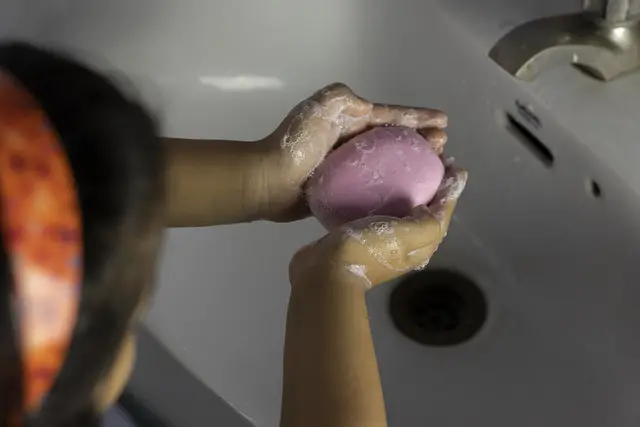There’s a range of water saving tips out there, but many of them might be aimed at adults.
In this guide, we outline 4 easy water savings tips and lessons specifically for kids.
We’ve adapted this guide around a previous guide about how adults/individuals can save water in their everyday life.
(*Note – this guide contains general information only, and not recommendations or professional advice)
Summary – How To Save Water For Kids
4 simple and easy tips that might be taught to children about saving water might involve:
Food/Snacks
There’s a water footprint to the food we eat
A few options with this in mind might be to:
– Swap a water intensive snack for a less water intensive one (when healthy and safe to do so)
– Don’t waste food, or throw out food that can otherwise be eaten
Shower/Bath
– Don’t overfill the bath more than necessary
– Don’t have unnecessarily long showers
Toilet
– When safe and suitable to do so, use half flush on toilet as opposed to full flush. Where full flush is necessary, flush only the amount of times necessary to clean the toilet safely and properly
– And, be mindful of not running the tap for an excessive amount of time when washing and cleaning hands afterwards
Tap/Faucet
– When using the tap/faucet in general for washing hands, or washing other things, run it only for the necessary time, and not excessively
– Fill the sink when suitable as opposed to running water e.g. when washing the dishes
1) Considering The Foods Eaten, & Food Waste
This might involve:
– Swapping a water intensive snack option like a chocolate bar for a less water intensive snack like a banana, apple or orange
Looking at the numbers – there might be more water that goes into making a chocolate bar compared to a banana when looking at it on a per weight basis according to some reports:
It takes … 450 gallons (1700 liters) of water to make a typical 3.5-ounce (100-gram) chocolate bar. That’s about ten bathtubs of water for one bar of chocolate. Most of those gallons are consumed by the cocoa plants in the field (blog.nationalgeographic.org)
The global average water footprint (per kg) is 860 litres for bananas, and 24,000 litres for chocolate (waterfootprint.org)
Read more about the water footprint of different foods in this guide
– Not wasting food, or throwing out food when it can otherwise be eaten
Instead, teaching kids to eat the food that is prepared, and learning to store leftovers where practical and safe to do so might be a way to address this
Food has a water footprint to grow and produce, and water is indirectly wasted when food is wasted (because food has an invisible water footprint too)
Food waste also has other impacts other than water waste to consider
2) Run Showers/Baths Only For As Long As Necessary
Two pretty easy steps to follow:
– Don’t overfill the bath more than necessary, or waste water unnecessarily when having a bath
– Don’t run the water excessively when in the shower, and be mindful of the amount of time spent in the shower
Another option is to fit your shower with a water efficient fixture/shower head for your kids to use.
3) Toilet Flushing
Most toilets these days should come with a full flush and half flush option.
As long as it is safe and practical to do so, teaching kids to use the half flush for number 1’s (urinating) is one way to save water over using full flush all the time.
Where full flush is required, flushing only the number of times that is required to clean the toilet in a practical and safe way is another behavior that can be practiced
When washing and cleaning hands afterwards, not running the tap/faucet for excessive amounts of time or in a wasteful way may be another tip
4) Be Mindful Of Running Taps/Faucets In General
When washing hands or items with taps and faucets in general, a few things to keep in mind might be:
– Not turning the tap on full speed when it isn’t required – slower can be adequate and use less water
– Being mindful of how long the tap or faucet is run for, and not excessively running it for longer than is required
– Kids can also fill a sink instead of running the tap when washing dishes
Also, fitting taps/faucets with water efficient heads is another way to save water when your kids use them.
Water Use & Saving Water In The Home
The following guides may have more tips for water savings tips for both adults and kids:
How Much Water We Use At Home & How We Use It
How Much Water Common Household Appliances & Devices Use
Sources
1. https://www.bettermeetsreality.com/how-much-water-we-use-at-home-how-we-use-it/
2. https://waterfootprint.org/media/downloads/Hoekstra-2008-WaterfootprintFood.pdf
3. https://blog.nationalgeographic.org/2015/02/12/love-water-for-chocolate/
4. https://www.bettermeetsreality.com/how-to-save-water-in-daily-life-simple-steps/
5. https://www.bettermeetsreality.com/foods-that-take-the-most-water-to-produce-make/
6. https://www.bettermeetsreality.com/how-to-decrease-the-water-footprint-with-the-foods-you-eat/
','' ); } ?>